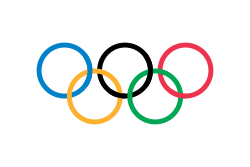Dimosthenis Tampakos
| Dimosthenis Tampakos | ||
| Gymnastik, herrar | ||
| Guld | Aten 2004 | Ringar |
| Silver | Sydney 2000 | Ringar |
Dimosthenis Tampakos (grekiska: Δημοσθένης Ταμπάκος), född den 12 november 1976 i Thessaloniki, Grekland, är en grekisk gymnast.
Han tog OS-silver i ringar i samband med de olympiska gymnastiktävlingarna 2000 i Sydney[1] och därefter OS-guld i ringar i samband med de olympiska gymnastiktävlingarna 2004 i Aten.[2]
Referenser
- ^ ”2000 Summer Olympics: Artistic Gymnastics, Rings, Men” (på engelska). olympedia.org. https://www.olympedia.org/results/70790. Läst 14 mars 2021.
- ^ ”2004 Summer Olympics: Artistic Gymnastics, Rings, Men” (på engelska). olympedia.org. https://www.olympedia.org/results/70874. Läst 14 mars 2021.
Källor
- Denna artikel är helt eller delvis översatt från motsvarande artikel på engelska wikipedia.
Externa länkar
- Dimosthenis Tampakos på Olympedia (engelska)
| |||||||||||||
Media som används på denna webbplats
De olympiska ringarna, med genomskinlig bakgrund.
(c) OOjs UI Team and other contributors, MIT
An icon from the OOjs UI MediaWiki lib.
US Flag with 45 stars. In use 4 July 1896–3 July 1908. Created by jacobolus using Adobe Illustrator, and released into the public domain. This flag was used during the Spanish-American War.
US Flag with 45 stars. In use 4 July 1896–3 July 1908. Created by jacobolus using Adobe Illustrator, and released into the public domain. This flag was used during the Spanish-American War.
Flag of the Socialist Federal Republic of Yugoslavia (1946-1992).
The design (blazon) is defined in Article 4 of the Constitution for the Republic of Yugoslavia (1946). [1]
Flag of the Socialist Federal Republic of Yugoslavia (1946-1992).
The design (blazon) is defined in Article 4 of the Constitution for the Republic of Yugoslavia (1946). [1]
US Flag with 48 stars. In use for 47 years from July 4, 1912, to July 3, 1959.
Olympic Movement flag
Proportions 2:3, created 1913, adopted 1914, first used 1920.
- Colors as per http://fairspielen.de/wp-content/uploads/2015/09/Annexe-3-Olympism_and_the_Olympic_Symbol_-_Principles_and_Usages_Guide-1.pdf
- blue: PMS 3005C
- yellow: PMS 137C
- black: PMS 426C
- green: PMS 355C
- red: PMS 192C
- Dimensions of the rings taken from http://fairspielen.de/wp-content/uploads/2015/09/Annexe-3-Olympism_and_the_Olympic_Symbol_-_Principles_and_Usages_Guide-1.pdf
Flagga Grekland (1822-1969) och (1974-1978), Årsdag flagga Grekland (1978 - )















